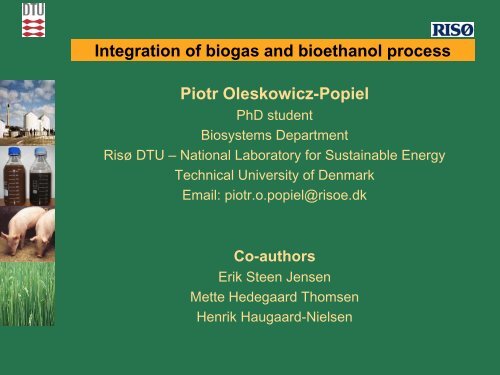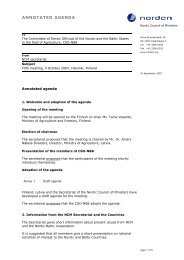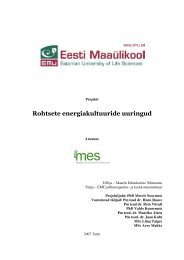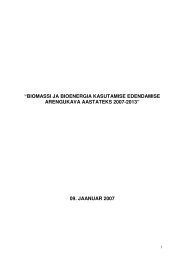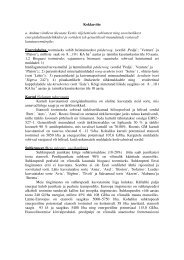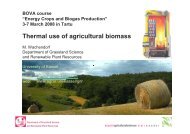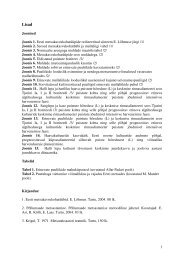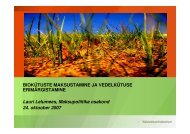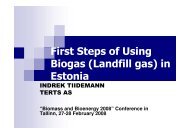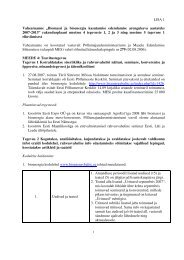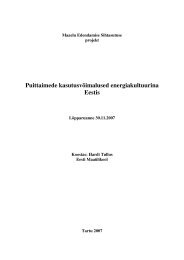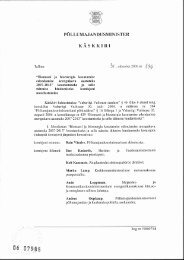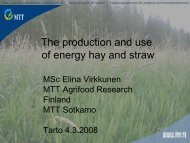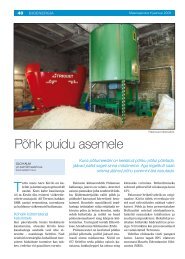possible integration of biogas+bioethanol processing - bioenergybaltic
possible integration of biogas+bioethanol processing - bioenergybaltic
possible integration of biogas+bioethanol processing - bioenergybaltic
Create successful ePaper yourself
Turn your PDF publications into a flip-book with our unique Google optimized e-Paper software.
Integration <strong>of</strong> biogas and bioethanol process<br />
Piotr Oleskowicz-Popiel<br />
PhD student<br />
Biosystems Department<br />
Risø DTU – National Laboratory for Sustainable Energy<br />
Technical University <strong>of</strong> Denmark<br />
Email: piotr.o.popiel@risoe.dk<br />
Co-authors<br />
Erik Steen Jensen<br />
Mette Hedegaard Thomsen<br />
Henrik Haugaard-Nielsen
Bioresources for bioenergy purposes<br />
Piotr Oleskowicz-Popiel<br />
2000 – 2003: bachelor at Poznan University <strong>of</strong> Technology,<br />
Department <strong>of</strong> Chemical Technology, PL<br />
2003 – 2005: MSc in Eng in Industrial Biotechnology,<br />
Aalborg University Esbjerg, DK<br />
2005 – 2007: research assistant, Department <strong>of</strong> Bioenergy<br />
Aalborg University Esbjerg/University <strong>of</strong> Southern Denmark<br />
2007 – present: PhD student, Biosystems Department,<br />
National Laboratory for Sustainable Energy<br />
and Technical University <strong>of</strong> Denmark (Risø DTU)
Integration <strong>of</strong> biogas and bioethanol process<br />
1. Sustainable production <strong>of</strong> bi<strong>of</strong>ules: biogas and bioethanol<br />
2. Second generation bi<strong>of</strong>uels: IBUS concept<br />
3. BioConcens Project<br />
4. Bioprocess modelling (with SuperPro Designer®)<br />
What is sustainability?<br />
What are the advantages from<br />
the co-production <strong>of</strong> bi<strong>of</strong>uels?<br />
First or second generation bi<strong>of</strong>ules?
Solar CO 2 H 2 O<br />
energy N,P,K,<br />
Sustainability assessment<br />
Biorefinery<br />
Products<br />
Industrial chemicals<br />
Bi<strong>of</strong>uels<br />
Electricity<br />
Heat<br />
Polymers<br />
Materials<br />
Fertilizers<br />
Food ingredients<br />
Feed<br />
Bioresources<br />
Biochemical<br />
Thermochemical<br />
Extraction<br />
Sustainability assessment<br />
4
Multifunctional land use<br />
Land use<br />
Goods<br />
Food<br />
Fibers<br />
Fuels<br />
Chemicals/materials<br />
Water protection<br />
Soil fertility<br />
Biodiversity<br />
Recreation<br />
Bioremediation<br />
5
Biomass-to-bi<strong>of</strong>uel pathways<br />
Biomass<br />
Lignocellulosic<br />
biomass<br />
Thermoche<br />
mical/gasification<br />
Pretreament and<br />
enz.hydrolysis<br />
Syngas<br />
2G technology<br />
Catalysed<br />
synthesis<br />
BTL<br />
F-T diesel<br />
DME<br />
Methanol<br />
Sugar<br />
Fermentation<br />
og destillation<br />
Ethanol<br />
Sugar- and<br />
starch crops<br />
Oil plants and animal<br />
fat<br />
Milling and<br />
enz. hydrolysis<br />
Extraction<br />
1G technology<br />
Transesterification<br />
Biodiesel<br />
Residues and<br />
organic waste<br />
Fermentation<br />
and cleaning<br />
Biogas<br />
and H 2<br />
Adapted from: Erik Steen Jensen: Lignocellulose-based bi<strong>of</strong>uel production –bioresources, technologies and sustainability<br />
6
Biomass-to-bi<strong>of</strong>uel pathways<br />
Bi<strong>of</strong>uels in the EU. A vision for 2030 and beyond. Final draft report <strong>of</strong> the Bi<strong>of</strong>uels Research Advisory Council<br />
7
Crops for 1G bi<strong>of</strong>uel<br />
8
1G bi<strong>of</strong>uels (ethanol and biodiesel) and associated crops<br />
• The use <strong>of</strong> known 1G crops and cultivations methods is not likely<br />
to influence positively the environment – but will increase the<br />
competition for land with other uses (feed and food)<br />
• The protein fraction <strong>of</strong> the biomass can be used for feed (DDGS<br />
and rapeseed cake)<br />
• Crop residues from food and feed crops can be used for 2G<br />
bi<strong>of</strong>uels to some extent<br />
• Cultivation <strong>of</strong> marginal soils (including set-aside) with annual crops<br />
increases the risk for loss <strong>of</strong> nutrients and transport <strong>of</strong> pesticides to the<br />
aquatic environment.<br />
• Some annual crops are problematic from an environmental point<br />
<strong>of</strong> view – e.g. maize and oilseed cultivation are associated with large<br />
leaching losses (table)<br />
Adapted from: Erik Steen Jensen: Lignocellulose-based bi<strong>of</strong>uel production –bioresources, technologies and sustainability<br />
9
Perennial crops for 2G bioethanol and BTL<br />
10
Lignocellulose - residues and waste<br />
11
Anaerobic Digestion (AD)<br />
Suspended organic matter<br />
Hydrolysis<br />
Proteins Carbohydrates Lipids<br />
Polypeptides<br />
Peptides Mono and disaccharides Volatile acids and glycerine<br />
AD is commonly used for the treatment<br />
<strong>of</strong> animal manure, organic waste from<br />
agriculture and urban areas and food<br />
industry.<br />
Acidogenesis<br />
Acetogenesis<br />
Organic compounds: volatile<br />
fatty acids, alcohols, lactic acid<br />
Mineral compounds: CO 2<br />
,<br />
H 2<br />
, NH 4+<br />
/NH 3<br />
, H 2<br />
S<br />
Acetic acid CO 2<br />
, H 2<br />
Microbiological conversion <strong>of</strong> organic<br />
matter to methane in the absence <strong>of</strong><br />
oxygen. The process is also known as<br />
the biogas process and has been<br />
widely utilized in wastewater treatment<br />
plants.<br />
Methanogenesis<br />
Methane production:<br />
CH 3<br />
COOH => CH 4<br />
+ CO 2<br />
(Acetotrophic methanogenesis)<br />
CO 2<br />
+ H 2<br />
=> CH 4<br />
+ H 2<br />
O (Hydrotrophic methanogenesis)<br />
adapted from: Benabdallah El-Hadj T. (2006) ISBN: 84-690-2982-7<br />
12
Sustainable cycle <strong>of</strong> Anaerobic Digestion<br />
Anaerobic digestion is a natural<br />
process during which bacteria<br />
break down the carbon in<br />
organic material<br />
The biogas plant has<br />
three main products:<br />
-biogas (source <strong>of</strong> energy)<br />
-liquid fertilizer<br />
-fiber for compost<br />
Al Seadi T.: Good practice in Quality Management <strong>of</strong> AD Residues; Task 24 – Energy from Biological Conversion <strong>of</strong><br />
Organic Waste; Department <strong>of</strong> Bioenergy; University <strong>of</strong> Southern Denmark.<br />
13
Utilisation <strong>of</strong> digestate<br />
• To be recycled as fertilizer, digestate must<br />
have a defined content <strong>of</strong> macronutrients.<br />
Average samples <strong>of</strong> digestate must also<br />
be analyzed for heavy metals and<br />
persistent organic contaminants, making<br />
sure that these are not exceeding the<br />
detection limits permitted by law.<br />
• The application <strong>of</strong> digestate must be done<br />
on the basis <strong>of</strong> a fertiliser plan, elaborated<br />
for each agricultural field. The experience<br />
shows that an environmental and<br />
economic suitable application <strong>of</strong> digestate<br />
fulfils the phosphorus requirements <strong>of</strong> the<br />
crops and completes the nitrogen<br />
requirements from mineral fertiliser.<br />
Al Seadi T. ed.: Biogas from AD, Bioexell training manual; Department <strong>of</strong> Bioenergy; University <strong>of</strong> Southern Denmark.<br />
14
Digestate as a fertilizer<br />
Highly efficient fertiliser can be achieved<br />
from co-digestion <strong>of</strong> cow manure (high in<br />
potassium), pig manure (high in<br />
phosphorous), and suitable agricultural<br />
wastes and by-products. Due to the fact<br />
that the digestate is nutritionally defined, it<br />
can be used very efficiently. Application <strong>of</strong><br />
digestate as bio-fertiliser decreases<br />
nutrients loss as well as pollution <strong>of</strong> water<br />
from nutrients. Additionally, it results in<br />
saving energy consumption for production<br />
<strong>of</strong> chemical fertiliser. To obtain all these<br />
benefits though it is necessary to apply<br />
what is called a “good agricultural practice”<br />
Nordberg A., Edstrom M.: Waste management in<br />
northern Europe: experiences from the Linkoeping<br />
biogas plant. European workshop: Impact <strong>of</strong> Waste<br />
Management Legislation on Biogas Technology,<br />
Tulln, Austria, September 12-14, 2002.<br />
Parameter<br />
Total solids [%] 4.5<br />
Volatile solids [%TS] 75<br />
pH 8.1<br />
Total-N [kg/m 3 ] 7.2<br />
Ammonia-N [kg/m 3 ] 4.9<br />
P [kg/m 3 ] 0.7<br />
K [kg/m 3 ] 1.0<br />
Digestate<br />
Linkoeping<br />
Pb [mg/kgTS]
Digestate as a fertilizer<br />
Average concentrations <strong>of</strong> nitrogen, ammonia, and phosphorous in digestate from Danish<br />
centralised co-digestion plants<br />
http://www.mst.dk/default.asp?Sub=http://www.<br />
mst.dk/udgiv/publikationer/2004/87-7614-282-<br />
5/html/kap04.htm - Danish Environmental<br />
Protection Agency, Danish Ministry <strong>of</strong> the<br />
Environment<br />
Biogas plant<br />
Total N<br />
[kg/ton]<br />
NH 4<br />
-N/NH 3<br />
[kg/ton]<br />
P<br />
[kg/ton]<br />
Blaabjerg 4,75 3,25 1,1<br />
Blåhøj 5,30 3,8 0,84<br />
Fangel 5,83 4,38 0,92<br />
Filskov 4,90 3,7 0,94<br />
Hashøj 5,05 3,9 0,78<br />
Lemvig 4,28 3,02 1,2<br />
Lintrup 5,00 3,26 1,3<br />
Nysted 4,84 3,79 0,90<br />
Ribe 4,6 3,2 0,9<br />
Sinding-Ørre 2,6 2,2 1,2<br />
Snertinge 4,3 3,0 1,3<br />
Studsgård 3,86 2,79 0,86<br />
Thorsø 4,80 3,6 0,96<br />
16
Safe recycling <strong>of</strong> digestate<br />
Good agricultural practice - experience from Denmark<br />
• Source sorting and separate collection <strong>of</strong> digestible wastes, preferably in<br />
biodegradable recipients.<br />
• Selection / excluding from AD <strong>of</strong> the unsuitable waste types / loads, based<br />
on the complete declaration <strong>of</strong> each load: origin, content <strong>of</strong> heavy metals<br />
and persistent organic compounds, pathogen contamination, other potential<br />
hazards etc.<br />
• Periodical sampling and analysing <strong>of</strong> the biomass feedstock.<br />
• Extensive pre-treatment/on site separation (especially for unsorted waste).<br />
• Process control (temperature, retention time etc.) to obtain a stabilised end<br />
product.<br />
• Pasteurization / controlled sanitation for effective pathogen reduction.<br />
• Periodical sampling, analysing and declaration <strong>of</strong> digestate.<br />
• Including digestate in the fertiliser plan <strong>of</strong> the farm and using a “good<br />
agricultural practice” for application <strong>of</strong> digestate on farmland.<br />
Al Seadi T. ed.: Biogas from AD, Bioexell training manual; Department <strong>of</strong> Bioenergy; University <strong>of</strong> Southern Denmark.<br />
17
Ethanol fermentation<br />
IBUS<br />
http://www.nasa.gov<br />
H(C 6 H 10 O 5 ) n OH enzymes n C 6 H 12 O 6<br />
162 kg 180 kg<br />
n C 6 H 12 O 6 yeast 2n C 2 H 5 OH + 2n CO 2<br />
180 kg 92kg 88kg<br />
From the chemist/engineer point <strong>of</strong> view<br />
Jacqus K. et al.: The Alcohol Textbook. 3rd edition, Nothingam<br />
University Press, 1999.<br />
From the microbiologist point <strong>of</strong> view<br />
18
Biomass to bioethanol<br />
Mandil C. eds.: Bi<strong>of</strong>ules for transport. An international perspective. IEA, 2004.<br />
19
Lignocellulose degradation<br />
Lignocellulose<br />
pre-treatment<br />
cellulose*<br />
carboxylic acids + CO 2 + H 2 O<br />
+ lignin degradation products<br />
hemicellulose*<br />
*source: Bjerre A.B., Skammelsen<br />
Schmidt A.: Development <strong>of</strong> Chemical<br />
and Biological Processes for Production<br />
<strong>of</strong> Bioethanol: Optymalization <strong>of</strong> the Wet<br />
Oxidation Process and Characterization<br />
<strong>of</strong> Products, Risø National Laboratory,<br />
1997, Roskilde, Denmark [Riose-R-<br />
967(EN)]<br />
20
Bioethanol and Biogas potential<br />
Petersson et al.: Potential bioethanol and biogas production using lignocellulosic biomass from winter rye, oilseed rape and<br />
faba bean. Biomass and Bioenergy 31 82007) 812-819.<br />
21
Biogas and Bioethanol potential<br />
Petersson et al.: Potential bioethanol and biogas production using lignocellulosic biomass from winter rye, oilseed rape and<br />
faba bean. Biomass and Bioenergy 31 82007) 812-819.<br />
22
Real life example<br />
The principles:<br />
-About one-third <strong>of</strong> the corn—the starch—is converted<br />
into ethanol, and another one-third into thin stillage,<br />
which is used in the anaerobic digesters for heat and<br />
biogas. The other one-third, a combination <strong>of</strong> protein,<br />
oils, and fibers called distiller's grain, is usually sold as<br />
feed for cattle. However, this grain is wet when it exits<br />
the ethanol plant, and traditionally equipment costing<br />
several million dollars must be used to dry it before<br />
transport in order to prevent spoilage<br />
-Corn byproducts, including cellulose from the corn<br />
stalks, also go into the biogas brew.<br />
- the water pollution problems are solved by removing<br />
manure from feedlots<br />
How can we improve the system?<br />
How can we increase sustainability <strong>of</strong> the process?<br />
http://www.e3bi<strong>of</strong>uels.com<br />
23
Integration <strong>of</strong> biogas and bioethanol process<br />
1. Sustainable production <strong>of</strong> bi<strong>of</strong>ules: biogas and bioethanol<br />
2. Second generation bi<strong>of</strong>uels: IBUS concept<br />
3. BioConcens Project<br />
4. Bioprocess modelling (with SuperPro Designer®)<br />
First or second generation bi<strong>of</strong>ules?<br />
Based on: Mette Hedegaard Thomsen<br />
Biomass & Bioenergy Conference, 27th-29th <strong>of</strong> February 2008, Tallinn, Estonia
1. generation 2. generation<br />
The use <strong>of</strong> known 1G crops and<br />
cultivations methods is not likely to<br />
influence positively the environment – but<br />
will increase the competition for land with<br />
other uses (feed and food)<br />
Crop residues from food and<br />
feed crops can be used for 2G<br />
bi<strong>of</strong>uels to some extent<br />
Adapted from: Erik Steen Jensen: Lignocellulose-based bi<strong>of</strong>uel production –bioresources, technologies and sustainability<br />
25
Lignocellulose degradation<br />
Lignocellulose<br />
pre-treatment<br />
cellulose*<br />
carboxylic acids + CO 2 + H 2 O<br />
+ lignin degradation products<br />
hemicellulose*<br />
*source: Bjerre A.B., Skammelsen<br />
Schmidt A.: Development <strong>of</strong> Chemical<br />
and Biological Processes for Production<br />
<strong>of</strong> Bioethanol: Optymalization <strong>of</strong> the Wet<br />
Oxidation Process and Characterization<br />
<strong>of</strong> Products, Risø National Laboratory,<br />
1997, Roskilde, Denmark [Riose-R-<br />
967(EN)]<br />
26
2. generation Bioethanol production<br />
Enzymes<br />
Microorganism<br />
C5<br />
Pretreatment<br />
Hemicellulose<br />
Hydrolysis<br />
Enzymes<br />
Fermentation<br />
Yeast<br />
Cellulose<br />
C6<br />
Bio-Ethanol<br />
Lignin<br />
Hydrolysis<br />
Fermentation<br />
Distillation<br />
27
Co-production Bi<strong>of</strong>uels (EU-project: 2003-2006, Danish project: 2006-2009)<br />
Objective: Co-production <strong>of</strong> electricity and bioethanol<br />
Goal: Construction and testing <strong>of</strong> a pilot scale pretreatment reactor system<br />
with a planned capacity <strong>of</strong> 1000 kg <strong>of</strong> biomass per hour.<br />
Integrated Biomass Utilisation System (IBUS)<br />
1.step: Pilot scale reactor with a capacity <strong>of</strong> 100 kg/h<br />
Partners:<br />
Elsam A/S (DONG Energy)<br />
Risø National Laboratory - DTU<br />
The Royal Veterinary and<br />
Agricultural University<br />
TMO Biotech (EU-project)<br />
BioCentrum - DTU (Danish<br />
project)
IBUS 1000 kg/h plant<br />
195-200ºC<br />
90-100% cellulose<br />
convertibility<br />
50% hemicellulose<br />
recovery<br />
180ºC + 195ºC<br />
90-100% cellulose<br />
convertibility<br />
83% hemicellulose<br />
recovery
Advantages <strong>of</strong> the IBUS process<br />
• Simple and fast process<br />
• Enzymes and hot water<br />
• Process time < 100 h<br />
• Can be upscaled<br />
• Energy efficient<br />
• No milling<br />
• High dry matter (40%)<br />
• Power plant <strong>integration</strong><br />
• Flexible biorefinery<br />
• The lignin fraction contains sufficient energy to<br />
run the process!
Cut wheat straw<br />
Heat pretreated wheat straw<br />
31
High dry matter liquefaction <strong>of</strong> fibre fraction<br />
Larsen et al, 2006<br />
32
GHG balance for IBUS<br />
Grain<br />
Straw<br />
van Maarschalkerweerd, Risø (2006)<br />
33
How far are we? - Feasibility study<br />
Production cost for straw-based ethanol<br />
Ethanol prod. costs [$/gal]<br />
8<br />
7<br />
6<br />
5<br />
4<br />
3<br />
2<br />
1<br />
0<br />
20% 30% 40% 50% 60% 70% 80% 90% 100%<br />
Case 1<br />
Case 2<br />
Case 3<br />
Case 1 = C6, stand alone<br />
Case 2 = C6, integrated (with power plant)<br />
Case 3 = C6+C5, integrated<br />
Cellulose conversion ratio [%]<br />
Ref. Jan Larsen, Dong Energy, 28th Symposium on Biotechnology for Fuels and Chemicals, May 2006, Nashville.<br />
Latest feasibility study based on 1000 ton pr day IBUS ethanol plant located in the US (cost and<br />
income), corn stover 40 EUR/t DM and enzyme cost 0.14 EUR/liter ethanol.<br />
Raw production cost: 0.43 EUR/liter ethanol (2.40 US$/gal)<br />
World market price 0.35 EUR/liter, EU-market price 0.55 EUR/liter [Morgan Stanley Equity Research, oct. 2007]
AD manure as water and nutrient source<br />
Pre-treatment (Wet-Oxidation)<br />
Straw, Water or AD Manure<br />
SSF: Enzymes, Yeast<br />
Product: Ethanol<br />
Xylose Fermentation<br />
Product: Ethanol<br />
Source: Thomsen A.B., Medina C., Ahrling B.K.: Risø Energy Report<br />
2. Biotechnology in ethanol production. Risø National Laboratory,<br />
Denmark, November 2003.<br />
Anaerobic Digestion<br />
Product: Biogas<br />
Oleskowicz-Popiel P. et al.: Ethanol production from maize silage as lignocellulosic biomass in anaerobically<br />
digested and wet-oxidized manure. Bioresource Technology. in press<br />
35
AD manure as water and nutrient source<br />
fermentation <strong>of</strong> IBUS straw in pre-treated AD manure and water<br />
ethanol [g/100g]<br />
1,8<br />
1,6<br />
1,4<br />
1,2<br />
1<br />
0,8<br />
0,6<br />
0,4<br />
0,2<br />
0<br />
0 20 40 60 80 100 120 140 160<br />
time [h]<br />
Straw+121.0<br />
Straw+121.12<br />
Straw+Water<br />
manure 121.12<br />
Successful ethanol<br />
fermentation in AD manure as a<br />
water and nutrient source<br />
3400<br />
3200<br />
ammonia [mg/L]<br />
3000<br />
2800<br />
2600<br />
2400<br />
2200<br />
2000<br />
0 20 40 60 80 100 120 140 160<br />
time [h]<br />
Straw 1 Straw 2 Maize 1 Maize 2<br />
Nitrogen uptake during ethanol<br />
fermentation.<br />
AD manure can be recirculated<br />
several times as a N-source<br />
36
Integration <strong>of</strong> biogas and bioethanol process<br />
1. Sustainable production <strong>of</strong> bi<strong>of</strong>ules: biogas and bioethanol<br />
2. Second generation bi<strong>of</strong>uels: IBUS concept<br />
3. BioConcens Project<br />
4. Bioprocess modelling (with SuperPro Designer)<br />
Is there a future for organic farming?
BioConcens<br />
• Biomass and Bioenergy Production in Organic Farming –<br />
Consequences for Soil Fertility, Environment, Spread <strong>of</strong> Animals<br />
Parasites and Socio-Economy.<br />
• The production <strong>of</strong> bi<strong>of</strong>ules in organic agriculture can reduce its<br />
dependency <strong>of</strong> fossil fuels and decrease GHG emission<br />
• It might increase sustainability <strong>of</strong> organic farming<br />
organic<br />
farming<br />
Main stream agriculture<br />
38
• DARCOF – The Danish Research Centre for Organic Farming:<br />
”The remit <strong>of</strong> DARCOF is to coordinate research for organic farming,<br />
with a view to achieving optimum benefit from the allocated<br />
resources. Its aim is to elucidate the ideas and problems faced in<br />
organic farming through the promotion <strong>of</strong> high quality research <strong>of</strong><br />
international standard.”<br />
http://www.darc<strong>of</strong>.dk<br />
• DARCOF III – research programme “International research<br />
cooperation and organic integrity”:<br />
BioConcens http://www.bioconcens.elr.dk/uk/<br />
39
• BioConcens – Biomass and bioenergy production in organic<br />
agriculture – consequence for soil fertility, environment, spread <strong>of</strong><br />
animal parasites and socio-economy<br />
• work package 1: Co-production <strong>of</strong> biogas, bioethanol and animal<br />
feed from organic raw materials:<br />
1. biogas potentials <strong>of</strong> raw materials<br />
2. co-production <strong>of</strong> biogas and fodder protein<br />
3. co-production <strong>of</strong> biogas and bioethanol<br />
40
BioConcens<br />
41
BioConcens – co-production <strong>of</strong> biogas and bioethanol<br />
• Bioethanol from starch can be substitute for diesel or gasoline. The<br />
method for bioethanol production from rye grain by utilizing the<br />
inherent amylase activity <strong>of</strong> the seed is going to be developed (to<br />
avoid GMO based enzymes)<br />
• Usage <strong>of</strong> natural enzymes and whey permeate as nutrients and<br />
process water in bioethanol fermentation will decrease production<br />
cost and increase sustainability <strong>of</strong> the process. Application <strong>of</strong> the<br />
effluent into the biogas process will be the additional advantage.<br />
42
BioConcens – co-production <strong>of</strong> biogas, bioethanol and fodder<br />
• The goal is to develop farm-scale, low energy demanding and “easy to<br />
handle” technology for production <strong>of</strong> bioethanol from rye grain. To keep the<br />
frame <strong>of</strong> organic farming natural enzymes will be applied (commercial<br />
enzymes will be used only for reference experiments). The remaining<br />
compounds will be recycled into biogas process.<br />
• Co-fermentation <strong>of</strong> clover grass (commonly grown in OA) with animal manure<br />
• Co-fermentation <strong>of</strong> clover grass with whey (co-production <strong>of</strong> energy and animal<br />
feed)<br />
43
BioConcens<br />
• From the energy balance point <strong>of</strong><br />
view, the most relevant utilization <strong>of</strong><br />
feedstocks and co-products will be<br />
modelled in SuperPro Designer<br />
(Intelligen, INC)<br />
• Bioenergy from organic sources<br />
should not negatively influence the<br />
carbon and nutrients cycle – the<br />
intelligent management <strong>of</strong> organic<br />
residues and crop rotation is<br />
necessary<br />
• Design and evaluate a combined<br />
concept for biomass and bioenergy<br />
production in OA (considering the<br />
soil fertility)<br />
44
Initial results – the idea does really work<br />
Ethanol concentration (g/L)<br />
50<br />
40<br />
30<br />
20<br />
10<br />
0<br />
Malted rye, 13% dw<br />
Malted rye, 13% dw<br />
Comm. enz., 13% dw<br />
Comm. enz., 13% dw<br />
0 10 20 30 40<br />
Time (h)<br />
400<br />
300<br />
[mL CH4 / gVS]<br />
200<br />
100<br />
0<br />
0 5 10 15 20 25 30 35 40<br />
time [day]<br />
dry grass (low conc.)<br />
dry clover grass (low conc.)<br />
clover grass silage (low conc.)<br />
dry grass (high conc.)<br />
dry clover grass (high conc.)<br />
clover grass silage (high conc.)<br />
45
Integration <strong>of</strong> biogas and bioethanol process<br />
1. Sustainable production <strong>of</strong> bi<strong>of</strong>ules: biogas and bioethanol<br />
2. Second generation bi<strong>of</strong>uels: IBUS concept<br />
3. BioConcens Project<br />
4. Bioprocess modelling (with SuperPro Designer ® )<br />
How to design<br />
an environmentally friendly process?
Modeling <strong>of</strong> a bioprocess<br />
Process concept<br />
Process design and<br />
development<br />
Modeling and<br />
simulation<br />
Literature<br />
Patents<br />
Expert<br />
knowledge<br />
Improvements<br />
needed<br />
Sustainability<br />
assessment<br />
Not<br />
eco-efficient<br />
Stop<br />
Eco-efficient<br />
Industrial application<br />
adapted from:<br />
Heinzle E., et al., (2006)Development <strong>of</strong><br />
Sustainable Bioprocesses – Modelling and<br />
Assessment. John Wiley & Sons Ltd.<br />
47
Modeling <strong>of</strong> a bioprocess<br />
• in process development we should try<br />
understand <strong>of</strong> the actual production process<br />
as early and as detailed as <strong>possible</strong><br />
• the modeling <strong>of</strong> the process under<br />
development and a through assessment<br />
helps to improve this knowledge<br />
• the assessment should include economic<br />
and environmental evaluation<br />
• the simulation results are used to evaluate<br />
the process and to guide the R&D effort to<br />
the most promising directions and the most<br />
urgent problems<br />
• it is important to look at the whole process<br />
and not only to optimize single parts<br />
• the created models and the assessment<br />
based on these models include a certain<br />
inherent uncertainty; this uncertainty has to<br />
be considered and quantified<br />
48
Modeling <strong>of</strong> a bioprocess<br />
• besides the economic structure <strong>of</strong> a process, environmental and<br />
social aspects should be considered<br />
• process modeling and simulation enhances our insight and<br />
understanding <strong>of</strong> a process and helps to identify potential<br />
improvements as well as <strong>possible</strong> difficulties<br />
• in process development, simulation can supplement experiments<br />
49
Modeling <strong>of</strong> a bioprocess<br />
Define goal & process boundaries<br />
Collect data (internal and external)<br />
Define bioreactions<br />
Identify process flow diagram (unit operations and streams)<br />
Define unit operation models<br />
Perform simulations<br />
Make inventory analysis and assessment<br />
adapted from:<br />
50<br />
Heinzle E., et al., (2006)Development <strong>of</strong> Sustainable Bioprocesses – Modelling and Assessment. John Wiley & Sons Ltd.
Modeling <strong>of</strong> a bioprocess<br />
• What are required amounts <strong>of</strong> raw materials and utilities?<br />
• What is the required size <strong>of</strong> process equipment and supporting utilities?<br />
• Can the product be produced in an existing facility or a new plant is required?<br />
• What is the total capital investments?<br />
• What is the manufacturing cost?<br />
• What is the optimum batch size?<br />
• How long does the single batch take?<br />
• How much product can be generated per year?<br />
• What is the demand for raw materials, labor, utilities, etc.?<br />
• Which process step can be a bottleneck?<br />
• What changes can increase throughout?<br />
• What is the environmental impact <strong>of</strong> the process?<br />
• Which design is the best among several <strong>possible</strong> alternatives?<br />
adapted from:<br />
Petrides D., Bioprocess Design and<br />
Economics. Oxford University Press, 2003.<br />
51
Modeling <strong>of</strong> a bioprocess<br />
• After a model for the entire process is developed on the computer,<br />
tools like SuperPro Designer ® can be used to ask and readily answer<br />
”what if” questions and carry out sensitivity analysis with respect to<br />
key design variables.<br />
• SuperPro Designer ® - simulation program that is able to estimate<br />
both process and economic parameters.<br />
52
Modeling <strong>of</strong> a bioprocess<br />
• Computer simulations provide the ability to estimate the effect <strong>of</strong><br />
increasing costs <strong>of</strong> raw materials or utilities, variations in material<br />
compositions, and the incorporation <strong>of</strong> new technologies<br />
• Beginning with a base-case scenario and designing the model to<br />
simulate those conditions effectively allows the user to estimate<br />
results <strong>of</strong> alternative processes with confidence.<br />
photo: www.siteselection.com<br />
Kwiatkowski J.R. et al: Modeling the process and costs <strong>of</strong> fuel ethanol production by the corn dry-grind process.<br />
Industrial Crops and Products 23 (2006) 288-296<br />
53
Modeling the process - simplified flow diagram<br />
150 million l/year plant<br />
Kwiatkowski J.R. et al: Modeling the process and costs <strong>of</strong> fuel ethanol production by the corn dry-grind process.<br />
Industrial Crops and Products 23 (2006) 288-296<br />
54
Modeling the process - simplified flow diagram<br />
• Grain receiving<br />
• Liquefaction, saccharification, and fermentation – all the reaction,<br />
volumes, residence times, agitation/pumping power required, and<br />
other operating parameters may be adjusted to imitate an existing<br />
fermenter or make use <strong>of</strong> experimental data. The model will scale<br />
the unit to accommodate any change in raw material plant<br />
throughput<br />
• distillation and ethanol recovery<br />
• stillage <strong>processing</strong> –<br />
• final products – fuel ethanol (with app. 5% denaturant – gaoline),<br />
DDGS (an animal feed rich in protein – 27.8%)<br />
Kwiatkowski J.R. et al: Modeling the process and costs <strong>of</strong> fuel ethanol production by the corn dry-grind process.<br />
Industrial Crops and Products 23 (2006) 288-296<br />
55
Modeling the process - simplified flow diagram<br />
• The actual process contains more than 100 pieces <strong>of</strong> equipment and unit<br />
operations<br />
• The process simulator quantifies the <strong>processing</strong> characteristic, energy<br />
requirements, and equipment parameters <strong>of</strong> each major piece <strong>of</strong> equipment<br />
for the specified operating scenario.<br />
• Volumes, composition, and other physical characteristic <strong>of</strong> input and output<br />
streams for each equipment item are identified. This information becomes<br />
the basis <strong>of</strong> utility consumptions and purchased equipment costs for each<br />
equipment item.<br />
• Composition <strong>of</strong> a raw agricultural feedstock varies by year and location, this<br />
can be easy adjusted<br />
• Different raw materials can be input in the model. although, maybe some<br />
extra unit operation need to be given<br />
Kwiatkowski J.R. et al: Modeling the process and costs <strong>of</strong> fuel ethanol production by the corn dry-grind process.<br />
Industrial Crops and Products 23 (2006) 288-296<br />
56
Cost model description<br />
• Equipment costs<br />
• Feedstock costs<br />
• Product values<br />
• Utility costs<br />
• Capital costs<br />
• Annual production and unit costs<br />
• Sensitivities<br />
Kwiatkowski J.R. et al: Modeling the process and costs <strong>of</strong> fuel ethanol production by the corn dry-grind process.<br />
Industrial Crops and Products 23 (2006) 288-296<br />
57
Lysine flow sheet<br />
The lactic acid fermentation <strong>of</strong> brown juice in the green crop drying plant as it<br />
was simulated in SuperPro Designer<br />
Thomsen MH: Complex media from <strong>processing</strong> <strong>of</strong> agricultural crops for microbial fermentation.<br />
Mini-Review, Appl. Microbiol. Biotechnol (2005) 68: 598-606<br />
58
Priority <strong>of</strong> sustainable land and bioresource use<br />
Erik Steen Jensen<br />
59


